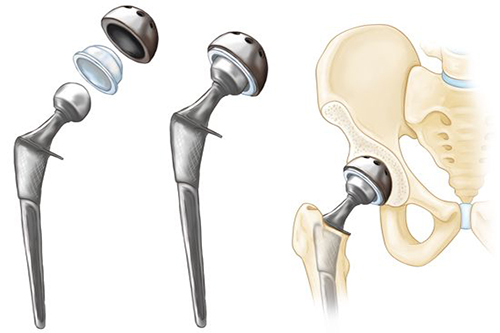
Do you have a grandparent or parent that has had to go through a total hip replacement surgery? Maybe you yourself have experienced an unfortunate and painful diagnosis in your hip, and more conservative approaches weren’t successful, requiring the procedure in order for you to live a life without pain. A total hip replacement (THA) is a common surgery that can be very successful for many people.
The hip joint is a ball and socket joint, meaning the round head of your femur (thigh bone) sits inside a socket of bone (the pelvis). The surfaces of the bones are lined with cartilage tissue that allow the bones to move smoothly over each other when you move your hip. There are a number of diagnoses that could result in the need for a THA, but the most common cause for chronic hip pain is arthritis (osteoarthritis, rheumatoid arthritis, or post-traumatic arthritis). These various forms differ, but in all cases the cartilage and connective tissue either has degenerative “wear and tear” changes or inflammation, causing pain in the hip.
But what exactly is entailed with a total hip replacement surgery? When conservative treatments have been unsuccessful, it may be necessary to resolve the pain. When a doctor performs a total hip replacement, he removes the damaged bone and cartilage and replaces the ball and socket portion of the hip with artificial parts. More specifically, the damaged head of your femur is removed and replaced with a metal stem that is inserted into the center of the femur and a metal or ceramic ball is used at the top of the stem. The damaged surface of the socket is removed and replaced with metal material and a plastic liner is inserted between the ball and the socket for a smooth glide of the surfaces when the hip moves.
Physical therapy can play a big part in your recovery and return to your previous level of function prior to your hip pain and surgery. You will likely start physical therapy the day after your surgery. Your physical therapist will educate you on the precautions to follow in order to prevent reinjury. He/she will also educate you about safe ways to move in bed and transition to different positions like lying down to seated, seated to standing, walking with an assistive device, etc. As you progress in your recovery you will likely continue physical therapy for a number of weeks after surgery in an outpatient clinic setting. Your sessions will focus on gaining full movement of the hip in all directions, strengthening around the hip and in the legs, balance, and training for you to perform the functions that are required of you in your every day life. Your physical therapist should create a unique and specific to you program to attempt to return you to your highest possible level of function.
If you currently have a healthy hip, there are definitely things you can do to attempt to maintain health in your joints and slow the progression of something like arthritis. A consistent healthy lifestyle involving regular exercise (conditioning, stretching, and strengthening) and healthy eating habits will help to keep your joints healthier longer!


